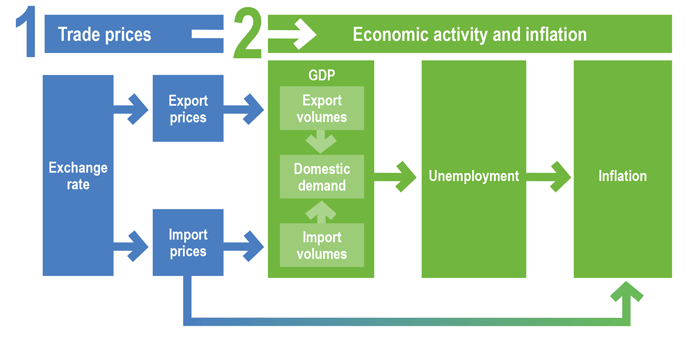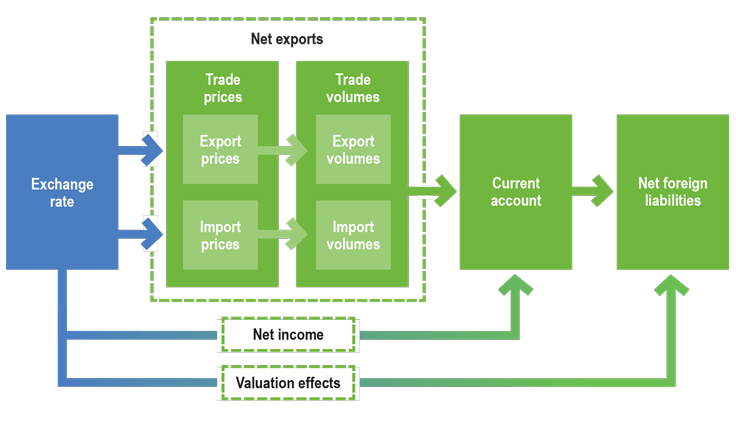Percent Change of Us Dollar Again Austrailian Dollar 201415
Exchange Rates and the Australian Economy
Download the complete Explainer 104KBAn exchange rate is the value of i currency in terms of another currency. Exchange rates matter to Australia's economy considering of their influence on merchandise and fiscal flows between Australia and the residual of the globe. Changes in exchange rates touch the Australian economy in two main ways:
- There is a direct effect on the prices of goods and services produced in Commonwealth of australia relative to the prices of appurtenances and services produced overseas.
- At that place is an indirect effect on economical activity and inflation every bit changes in the relative prices of goods and services produced domestically and overseas influence decisions about production and consumption.
Together these effects also have implications for the residual of payments. This Explainer describes the effects of exchange rate movements and highlights the master channels through which these changes touch the Australian economic system.

This explainer outlines these two stages and highlights some of the primary channels through which monetary policy affects the Australian economy.
If the exchange rate betwixt the Australian dollar and the US dollar is 0.75 then one Australian dollar can be converted into US75c. An increase in the value of the Australian dollar is called an appreciation. A decrease in the value of the Australian dollar is known every bit a depreciation.
Exchange rates and economic activeness

Direct Effects
The straight consequence of an exchange rate movement is to modify the prices of goods and services produced in Australia relative to the prices of appurtenances and services produced overseas. When the Australian dollar depreciates, or loses value, less foreign currency is required to purchase a given amount of Australian dollars. This makes Australian produced goods and services cheaper than before when compared with goods and services produced overseas. For case, if the Australian dollar depreciates, tourists visiting Australia volition demand to change less foreign currency to pay for their meals and hotel rooms in Australia. An appreciation of the Australian dollar volition have the opposite event – Australian produced appurtenances and services will become more expensive compared to goods and services produced overseas. If the Australian dollar appreciates, Australian tourists volition demand to change fewer Australian dollars to pay for their meals and hotel rooms overseas.
Indirect Effects
The indirect furnishings of exchange charge per unit movements arise considering changes in the relative prices of Australian and overseas goods and services affect economic activity and inflation in Australia. To highlight this, we use the instance of a depreciation of the Australian dollar. (An appreciation of the Australian dollar has the opposite upshot on economic activity and aggrandizement.)
Economical activity and the labour market place
By reducing the relative price of Australian produced goods and services, a depreciation of the Australian dollar increases the international competitiveness of Australian exporters. Because Australian appurtenances and services have become cheaper relative to overseas goods and services, strange consumers and firms will need more than Australian goods and services, leading to an increase in the book (that is, quantity) of Australian exports.
At the same time, following an exchange rate depreciation, imported goods and services become relatively more expensive for Australian consumers and firms. In response, Australian residents are likely to alter their consumption patterns to need more import-competing goods and services produced in Australia, leading to a subtract in the volume of imports.
Relative changes in export and import prices arising from a change in the commutation rate mainly influence demand for tradable goods and services. But commutation rate movements also have implications for the demand for not-tradable goods and services. In the case of depreciation, the resulting increment in export volumes and decrease in import volumes will increment national income in Australia. This, in plough, will increase need for non-tradable goods and services produced in Australia. In order to meet the increased need for their products, Australian firms will take to hire more than workers, which will increment employment and lower the unemployment rate in Australia.
Inflation and interest rates
In principle, a depreciation of the commutation rate will increase inflation in two ways. First, the prices of imported appurtenances and services will increase, contributing to aggrandizement. Second, the expansion of amass need and increase in employment will cause an increment in wages and other costs that are inputs to production and may be passed on to prices more generally, which will also contribute to higher inflation.
Should these factors contribute to excessive aggrandizement, the Reserve Bank may demand to tighten monetary policy in order to achieve its aggrandizement target.
In practice, in that location is typically a lag between an exchange rate motility and its issue on economical activity and inflation. In the discussion to a higher place we accept assumed substitution rate changes are immediately reflected in the prices of imported goods and services. Merely firms selling imported items ofttimes price them in Australian dollars, so information technology is up to the house selling the particular to decide when to pass on the higher cost (from the depreciation) to those buying the product. Substitution rates are volatile, and firms may be reluctant to change their prices until they are sure that an exchange charge per unit motility will not opposite. Fifty-fifty later on prices adjust, information technology may accept fourth dimension for households and firms to accommodate their spending patterns. The extent and timing of the responses will also depend on how easy it is for households and firms to substitute between goods and services produced in Australia and goods and services produced overseas. Almost estimates advise that it takes between one and three years for exchange rate movements to have their maximum consequence on economic activeness and inflation.
Balance of Payments
Exchange rates and the residue of payments
When considering the implications of exchange charge per unit movements for economic action what matters is the alter in the volume, or quantity, of exports and imports. In determining the consequences of commutation charge per unit movements for the balance of payments, all the same, information technology is the value – that is the prices likewise every bit the quantity – of exports and imports that matters. In one case over again, we use the case of a depreciation of an Australian dollar to describe these effects.
The direct effect of an substitution rate depreciation is to increase the price of imports relative to exports, which volition tend to decrease the value of internet exports (exports less imports) and widen the current account deficit. All the same, the indirect furnishings of an substitution rate depreciation increase the volume of exports and reduce the book of imports. This will tend to increase internet exports and diminish the current account deficit.

These two effects differ in their timing. The straight outcome of an exchange rate depreciation occurs immediately, while the indirect effects on export and import volumes typically occur with a lag. Because of this, in the short run, an exchange rate depreciation is likely to reduce the value of net exports. Only over time, as consign and import volumes commencement to respond, an exchange rate depreciation is likely to increase the value of net exports. This design is sometimes referred to as the 'J-curve'.
Exchange charge per unit movements also touch on the other major component of the current account – the net income arrears. An exchange rate depreciation volition increment the cost to Australian residents of servicing foreign debt that is denominated in strange currency. This is because the amount of Australian dollars required to purchase the strange currency needed to pay the interest owed on the debt has increased. This increases net income outflow and widens the electric current account deficit. On the other paw, an substitution rate depreciation will increment the income that Australian residents receive on their foreign nugget holdings, as the returns on those assets are at present larger in terms of Australian dollars. This reduces internet income outflow and narrows the current account arrears. (Although Australia'south foreign liabilities exceed its foreign avails, a large proportion of the foreign liabilities are denominated in Australian dollars so that a depreciation of the Australian dollar will actually tend to diminish Commonwealth of australia's net income arrears. This is considering the interest owed on the strange liabilities is not affected past the change in the commutation rate but the returns on the foreign assets are.)
An substitution rate depreciation has an additional issue on the balance of payments through valuation effects on Australia'south net foreign liabilities. Valuation effects occur considering a depreciation of the Australian dollar increases the value in Australian dollars of assets and liabilities denominated in foreign currency. As was the case for the internet income deficit, because the foreign assets of Australian residents that are denominated in strange currency exceed the liabilities of Australian residents denominated in strange currency, an commutation rate depreciation will tend to reduce the value of Australia's net foreign liabilities.
Source: https://www.rba.gov.au/education/resources/explainers/exchange-rates-and-the-australian-economy.html
0 Response to "Percent Change of Us Dollar Again Austrailian Dollar 201415"
Enviar um comentário